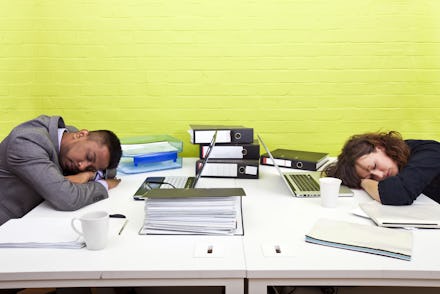This Is How You Take the Perfect Nap, According to Sleep Scientists

Not all naps are created equal.
Even experienced nappers have lived through the attempted nap-turned-into-deep slumber, or the restless tossing and turning that accompanies the nap-that-never-happened.
This is because napping is part-science and part-skill. It requires careful preparation and execution. The good news? Everyone can take the ultimate nap, as long as they set themselves up for success.
Sleep experts have been studying the science of napping for about 40 years, which is how long ago Cornell University psychologist James Maas coined the term "power nap." It was Maas who first suggested that workers should take a nap for 20 minutes rather than break to guzzle caffeine. Since then, other studies have linked napping to lower levels of heart disease, sharper memory and more fluid creative thinking.
Leveraging research that studies how we sleep, we put together the ultimate roadmap for the perfect nap. Whether you have access to a quiet, plush nap pod or nothing but an empty bathroom stall in your office hallway, here's how to achieve your desired beauty rest:
Naps should be 20 minutes or 90 minutes, and nothing in between.
We sleep in cyclical phases. Waking up during a deep sleep phase can cause sleep inertia, aka sleep drunkenness: that state of groggy disorientation that many of us know all too well. So, you want to wake up before deep sleep begins (generally by the 30-minute mark) or sleep through a full REM cycle, which takes about 90 minutes. That means you should set an alarm (or three) so you successfully rise at the right point in your sleep cycle.
Have caffeine right before you take a nap.
The caffeine nap is real.
If you're taking a short nap, consider having coffee immediately beforehand, said Kevin Morton, who started End-Your-Sleep-Deprivation.com after working with William Dement, the "father of sleep medicine" at Stanford University. Caffeine takes about 15 to 30 minutes to kick in. So, if your nap ends approximately when the caffeine takes effect, you can benefit from two sources of alertness.
Surround yourself with a consistent noise level.
You want to get away from jarring, abrupt sounds that will jolt you awake during your nap. But don't stress about the type of noise. Go for the noise environment that you personally find relaxing, whether that means silence, white noise from an app, or the rumble of city traffic. You do you.
Target the afternoon slump.
You don't need to schedule a nap too precisely, but most people feel drowsy about six to seven hours after waking up, said Maas. Napping should be restorative without affecting your nightly slumber, so you don't want to nap too closely to bedtime. Avoid conking out after 4 p.m, some experts say.
This nap wheel, from sleep psychologist Sara Mednick, purports to identify your ultimate napping window based on when you wake up. Ideally, according to the wheel, you want to nap when REM and slow-wave sleep cycles cross.
It's okay if you don't actually fall asleep.
Just resting your eyes, without actually dozing off, can actually help restore wakefulness, said Maas. Even if you're sleep-starved, it generally takes 15 to 20 minutes on average to fall asleep. And if you really do pass out as soon as your head hits the pillow, Maas said, you're battling severe exhaustion.
Lie down
A study found that napping position matters. For the sake of restoring alertness, lying down is best. In fact, you should get as comfy as possible: The saying that "beds are only for sleep and sex" is spot-on, said Maas. But naps fall into the sleep category. If you're not at home, head to the softest, most bed-like spot you can find. And if you can't find a comfy napping spot, check out Google naps, a crowdsourced bank of places to nap around your city.
Meditate
People who practice mindful meditation believe that the key to drifting off is harnessing the right state of mind. Basically, you need to focus consciously on relaxing your body without stressing about falling asleep. There are a bunch of simple techniques to test out. You can visualize a calming scene or picture yourself when you're really exhausted. Or, try consciously tensing and relaxing each part of your body, starting with your toes and working up.
Turn down the thermostat.
Don't believe the myth that heat makes you tired. Sitting in a warm room just unmasks existing drowsiness, said Maas. It's actually easier to enter deep sleep when it's cool — 65 to 70 degrees is the sweet spot. A drop in core body temperature, research suggests, sparks feelings of sleepiness. Insomniacs, in fact, tend to run higher body temperatures.
Make your nap environment smell great.
Aromatherapy, studies suggest, increases sleep quality and decreases the amount of time it takes to wake up. Consider toting a lavender-scented sleep mask or a bottle of essential oil to work if you're planning ahead to nap.
Now that you're skilled in the napping game, get to it. Sleep deprivation takes an enormous toll on our bodies, including bloodshot eyes, increased blood pressure and a fuller waistline — not to mention the impact on our brain.
Happy napping.